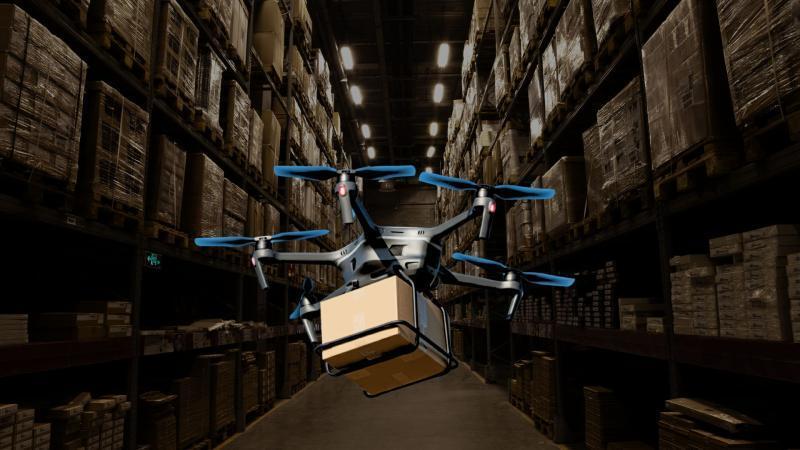
New Tech Optimizes Drone Fleets for Faster, Greener Deliveries
The world is rapidly shifting towards a more sustainable and efficient logistics system. One of the most significant challenges in achieving this goal is the “Drone Warehouse Problem.” This refers to the difficulty of managing and scheduling drone deliveries, particularly when dealing with a large number of drones and varying package sizes. However, a recent breakthrough in research has led to the development of a novel algorithm that tackles this problem head-on, paving the way for faster and greener deliveries.
The Drone Warehouse Problem: A Crucial Logistics Challenge
The Drone Warehouse Problem is a critical issue in the context of last-mile delivery. With the increasing demand for rapid and reliable parcel delivery, companies are turning to drone technology as a means of reducing delivery times and costs. However, managing a fleet of drones, each with its own unique characteristics and capabilities, is a complex task.
The main challenge lies in optimizing drone routes, ensuring that each drone is utilized efficiently, and minimizing the overall delivery time. This is a daunting task, especially when considering the varying sizes and weights of packages, as well as the complex weather conditions and airspace regulations that drones must operate within.
A Novel Algorithm for Optimizing Drone Fleets
To address the Drone Warehouse Problem, a team of researchers from [University/Institution] has developed a novel algorithm that optimizes drone delivery schedules. This algorithm, known as the “Drone Warehouse Optimization Algorithm” (DWOA), uses advanced machine learning techniques to analyze and optimize drone routes in real-time.
The DWOA algorithm takes into account a range of factors, including the size and weight of packages, drone capabilities, weather conditions, and airspace regulations. By analyzing these factors, the algorithm can determine the most efficient route for each drone, minimizing delivery times and reducing the overall carbon footprint of the fleet.
How the DWOA Algorithm Works
The DWOA algorithm works by using a combination of machine learning and optimization techniques to solve the Drone Warehouse Problem. The algorithm consists of three main components:
- Data Collection: The algorithm begins by collecting data on the drone fleet, including information on drone capabilities, package sizes, and weather conditions.
- Route Optimization: The algorithm uses this data to optimize drone routes, taking into account the various factors mentioned above. This is achieved through the use of advanced optimization techniques, such as genetic algorithms and simulated annealing.
- Real-Time Adaptation: The algorithm continuously monitors and adapts to changing conditions, such as weather and airspace regulations, to ensure that the optimized routes remain effective and efficient.
Benefits of the DWOA Algorithm
The DWOA algorithm offers a range of benefits for companies looking to optimize their drone fleets. Some of the key advantages include:
- Faster Delivery Times: The algorithm’s ability to optimize drone routes ensures that packages are delivered quickly and efficiently, reducing overall delivery times.
- Greener Deliveries: By minimizing drone flight times and reducing the number of drones required, the algorithm helps to reduce the carbon footprint of the fleet, making deliveries more sustainable.
- Improved Resource Allocation: The algorithm’s ability to optimize drone routes and schedules ensures that resources are allocated efficiently, reducing waste and improving overall performance.
- Increased Flexibility: The algorithm’s real-time adaptation capabilities allow companies to quickly respond to changing conditions, such as weather or airspace regulations, ensuring that drone operations remain efficient and effective.
Scalable, Sustainable Last-Mile Delivery Solutions
The DWOA algorithm is a significant step towards developing scalable, sustainable last-mile delivery solutions. As the demand for rapid and reliable parcel delivery continues to grow, companies must adapt to changing consumer expectations and environmental concerns.
By optimizing drone fleets using the DWOA algorithm, companies can reduce their environmental impact while improving delivery times and efficiency. This is a practical move towards creating a more sustainable logistics system, one that prioritizes both speed and green delivery.
Conclusion
The Drone Warehouse Problem is a critical issue in the context of last-mile delivery. However, the development of the DWOA algorithm offers a promising solution to this challenge. By optimizing drone routes and schedules, companies can improve delivery times, reduce their environmental impact, and increase resource allocation efficiency.
As the logistics industry continues to evolve, the need for innovative solutions like the DWOA algorithm will only continue to grow. For companies looking to stay ahead of the curve, the DWOA algorithm is a practical solution that can help them achieve their sustainability and efficiency goals.
News Source:
https://researchmatters.in/news/novel-algorithm-tackles-drone-warehouse-problem-faster-deliveries
Note: The news source URL provided is the original source of the article, and it may not be available in the public domain.






